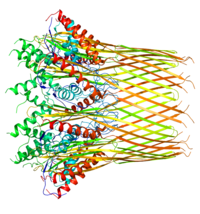
Photo from wikipedia
Curli fibers are functional amyloids that exhibit strong adhesion and robust self-assembly as biofilm structural components; however, the binding energetics and mechanical properties of wild-type curli are not well understood.… Click to show full abstract
Curli fibers are functional amyloids that exhibit strong adhesion and robust self-assembly as biofilm structural components; however, the binding energetics and mechanical properties of wild-type curli are not well understood. To address this, we present dimer structures made up of the major and minor curli subunits (CsgA and CsgB), perform free energy calculations to obtain absolute binding energies, and estimate the Young’s modulus and persistence length of curli fibers. Equilibrium molecular dynamics simulations are used to evaluate nonbonded interactions. Binding energies are most favorable for CsgB–CsgA, while CsgA–CsgA dimers have a higher binding energy than CsgB–CsgB despite possessing less favorable nonbonded interaction energies. Decomposing each potential of mean force of separation indicated that solvent effects positively impact CsgA–CsgA binding but not CsgB–CsgB and CsgB–CsgA. Charged residues and conserved polar residues were also notable contributors to attractive nonbonded interactions, underlining their importance in dimer assembly. Our findings elucidate sequence effects on binding energy contributions and establish theoretical limits for the elasticity, persistence length, and strength of curli fibers.
Journal Title: npj Computational Materials
Year Published: 2019
Link to full text (if available)
Share on Social Media: Sign Up to like & get
recommendations!